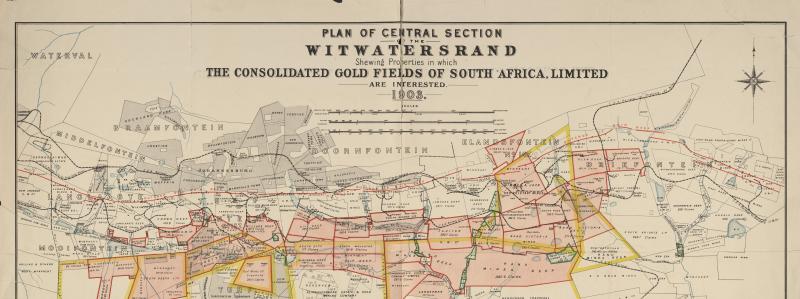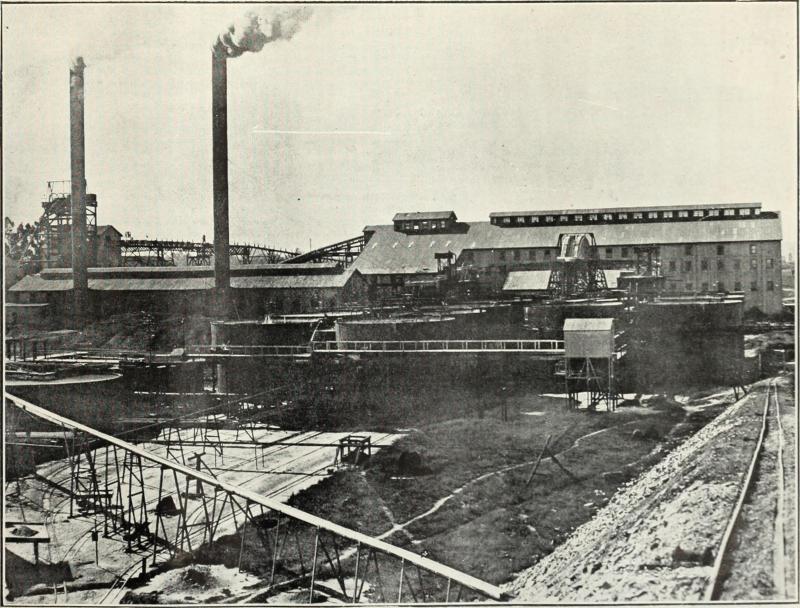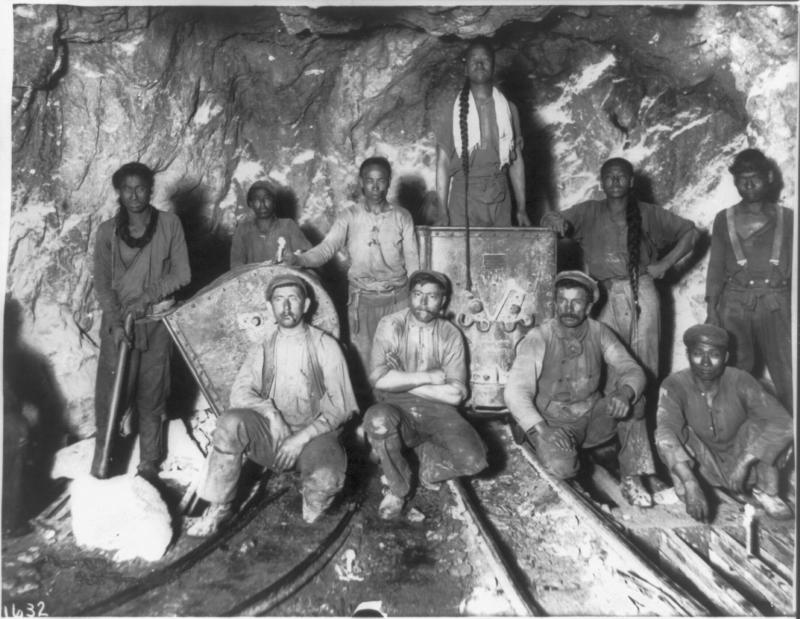The way mining transforms the environment tends to be imagined as spectacular and obvious: huge open pits clawed out of the earth, sprawling tailings dams, choked rivers, or a denuded landscape. This is not always the case. The discovery of vast gold deposits in what became the city of Johannesburg in South Africa in 1886 precipitated an environmental transformation that was both invisible and all-encompassing, by transforming the air.
Gold deposits were first spotted in rocky outcrops on a ridge known as the Witwatersrand (Rand) but, unlike the sites of previous nineteenth-century gold rushes, this gold-bearing reef sank sharply underground. Shallow hand-dug pits were rapidly replaced by underground mines that became the deepest on earth.

The line of the gold reef (marked with a red line) passing through the center of Johannesburg, 1903.
The line of the gold reef (marked with a red line) passing through the center of Johannesburg, 1903.
Courtesy of the library of Bordeaux Montaigne University.
 This work is licensed under a Creative Commons Public Domain Mark 1.0 License.
This work is licensed under a Creative Commons Public Domain Mark 1.0 License.
In this way, Johannesburg is built on gold in a literal sense. The gold mines that gave life to the city were sunk right through the city center, following the line of the reef. Even today, one of the country’s largest banks, Standard Bank, has an abandoned gold mine in the basement of its Johannesburg offices.
One consequence was that much of the city’s population lived in close proximity to working mines in the late nineteenth and early twentieth centuries. Gold was extracted using drilling and blasting by a racially divided workforce. In the hot, dry underground environment—Johannesburg is the world’s largest city not built alongside a river, lake, or coast—this produced enormous clouds of dust. One investigation in 1904 reported that anyone standing “with a drill at work boring dry holes becomes quickly covered in dust, and the grit is quickly noticeable, even in the mouth.”
The miners’ labor transformed the earth, and their own bodies. Within the clouds of dust were silica particles dislodged by extractions and these became embedded in the lungs, first of the miners and then of everyone else.
Beginning with a shortness of breath, silicosis, the disease caused by inhaling silica dust, is progressive and fatal. It can be years or even decades before the impact of silica particles is apparent, though in the early twentieth century the impact became clear very quickly as miners began dying in large numbers. Elaine Katz estimated that the total annual death rate among rock drillers reached a high of 109 per thousand in the 1900s.

Processing plant at Village Deep Mine, 1891.
Processing plant at Village Deep Mine, 1891.
Accessed via Flickr.
 This work is licensed under a Creative Commons Public Domain Mark 1.0 License.
This work is licensed under a Creative Commons Public Domain Mark 1.0 License.
Silica dust affected the nonhuman world too. The ponies and mules working underground seem to have suffered few cases, though this may be because they did not live long enough to develop silicosis or because the diseases they suffered from were not fully investigated. Rats and mice in the mines got silicosis though. Some mine managers kept mice underground to see what the dust levels would do to their lungs and, on dissection, concluded that silicosis in white mice “closely resembles the development of silicosis in a white miner.”
Contemporary regulations stipulated that silicosis could only be diagnosed as a cause of death when the symptoms could be identified in lungs by pathologists “by unaided sight and touch,” and specifically “without the aid of a microscope.” This was because by the early 1920s, postmortem examinations of virtually any adult who had lived in Johannesburg—not only miners—detected silica particles “associated with the essential changes of simple silicosis.” Microscopic investigation of lungs revealed that drilling and blasting far beneath the city had changed the air breathed in across the Rand.
This was not thoroughly inquired into because the gold industry had a strong incentive to downplay the impact of silicosis, as Jock McCulloch has argued. The presence of silica particles in the lungs of people who never worked underground suggests the disease could have been far more prevalent than the industry claimed. Gold companies sought strict limits on who could be diagnosed as suffering from silicosis because of the enormous cost implications.
Compensation mechanisms and testing regimes were gradually introduced following nine legislative acts, ten parliamentary inquiries, and six commissions into the disease between 1902 and 1925, following a ferocious struggle for protection by miners. Compensation, however, strongly favored white miners.

White, Black, and Chinese miners on the Rand, c. 1905.
White, Black, and Chinese miners on the Rand, c. 1905.
Courtesy of the Library of Congress.
 This work is licensed under a Creative Commons Public Domain Mark 1.0 License.
This work is licensed under a Creative Commons Public Domain Mark 1.0 License.
Regulations also changed the underground environment from dry to wet. Water hoses were attached to drills to suppress dust and this made underground spaces hot and humid for the Black African miners who did almost all the manual work. Consequently, these environmental changes largely changed the disease burden and shifted it from white to African miners.
Mining companies maintained a fiction that African miners were less prone to silicosis as statistical death rates were kept artificially low by repatriating sick African miners to rural areas. The miners themselves knew better. As early as the 1900s, Basotho migrants to the Rand referred to the mines as “cannibals,” places that ate away their bodies. The industry’s own reports occasionally revealed this. Postmortem examinations on the lungs of 194 deceased African miners in 1923 found silicosis was present in the lungs of 110 and in 78 was judged to have contributed to their death.
The extent of the terrible damage wrought by dust on the bodies of those who worked in the industry is now recognized by historians, but the impact of the disease may have been wider still and deserves further investigation. Johannesburg still faces many hazards from an industry now in terminal decline. Only a small proportion of the city’s inhabitants worked in the mines, but the mine dumps that pockmark the city, heavy metals left in the soils, and acid mine drainage threaten the health of those who never set foot underground, as silicosis may have done in the past.
How to cite
Money, Duncan. “The Struggle for Air: Mining, Dust, and Death on the South African Rand.” Environment & Society Portal, Arcadia (Spring 2023), no. 6. Rachel Carson Center for Environment and Society. doi:10.5282/rcc/9600.
ISSN 2199-3408
Environment & Society Portal, Arcadia
 This work is licensed under a Creative Commons Attribution 4.0 International License.
This work is licensed under a Creative Commons Attribution 4.0 International License.
2023 Duncan Money
This refers only to the text and does not include any image rights.
Please click on an image to view its individual rights status.
- Katz, Elaine. The White Death: Silicosis on the Witwatersrand Gold Mines, 1886–1910. Johannesburg: University of the Witwatersrand Press, 1994.
- Maloka, Tshidiso. “Basotho and the Experience of Death, Dying, and Mourning in the South African Mine Compounds, 1890–1940.” Cahiers d'Études Africaines 38, no. 149 (1998): 17–40. doi:10.3406/cea.1998.1975.
- Marks, Shula. “The Silent Scourge? Silicosis, Respiratory Disease and Gold-Mining in South Africa.” Journal of Ethnic and Migration Studies 32, no. 4 (2006): 569–89.
- McCulloch, Jock. “Air Hunger: The 1930 Johannesburg Conference and the Politics of Silicosis.” History Workshop Journal 72, no. 1 (2011): 118–37. doi:10.1093/hwj/dbr010.
- McCulloch, Jock. “Counting the Cost: Gold Mining and Occupational Disease in Contemporary South Africa.” African Affairs 108, no. 431 (2009): 221–40. doi:10.1093/afraf/adn085.
- Mushai, Albert. “The Long Road to Compensation for Silicosis Sufferers in South Africa.” Journal of Southern African Studies 46, no. 6 (2020): 1127–43.
- Rosental, Paul André, ed. Silicosis: A World History. Baltimore, MD: Johns Hopkins University Press, 2017.








